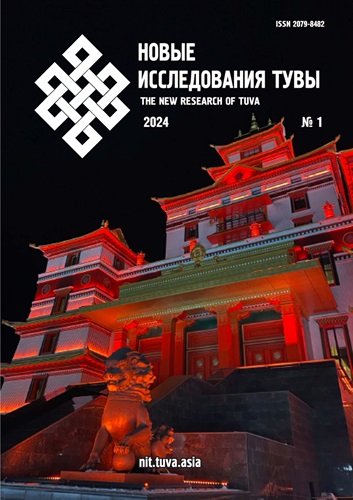Peacemaking potential of Tantric Buddhism in the Russian sociocultural space
DOI:
https://doi.org/10.25178/nit.2024.1.17Keywords:
tantric Buddhism; peacebuilding potential; soft power; Buddhist ethics; tantric practices; Buddhism in RussiaAbstract
The article examines the impact of tantric worldview practices on the socio-cultural space of Russia. Based on the analysis of Buddhist texts, it is determined that the essence of tantric practices lies in the realization of the emptiness nature of existence and the attainment of absolute power (Buddhahood) to aid all sentient beings. Following the process of tantric initiation, Buddhists engage in deity yoga, recognize interdependence, and cultivate compassion. The tantric pacifying fire puja of Shiva Jinseg is performed to eliminate various obstacles and promote universal well-being. Tantric consecration rituals for rabne and tantric ritual dances in the awareness of Buddhists initiate the harmonization process of the surrounding space.
Tantric deity yoga, as perceived by traditional Russian Buddhists (Kalmyks and Buryats), could have contributed to strengthening their relations with the imperial dynasty of Russia, to which the latter was attributed divine essence and a special spiritual mission. Evidence of the construction of Buddhist stupas and the performance of the Tsam ritual dance attests to the use of peace-building resources of tantric Buddhism in pre-revolutionary Russia.
Currently, in Kalmykia, Buryatia, Tuva, and other Russian regions, regular mass tantric initiations are conducted, predominantly for the meditational deity Kalachakra. Pacifying fire pujas are performed, religious objects are consecrated, and ritual dances are executed (Tsam mystery, Vajra Dance, Joyful dances of Kaita). The overarching goal of these practices is associated with the dissemination of ideals of global well-being.
Thus, tantric Buddhism can be considered as a “soft power” in contemporary conditions of societal and cultural development.
References
Agadzhanian, A. (2005) Buddhism in the Modern World: A Soft Alternative to Globalism. In: Religion and Globalization in Eurasia / ed. by A. Malashenko, S. Filatov. Moscow, Neostrom. 343 p. Pp. 222–255. (In Russ.).
Aiusheeva, D. V. (2011) The main features and trends in the spread of Tibetan Buddhism in the West. Religiovedenie, no. 4, pp. 74‒80. (In Russ.).
Badmaev, V. N. (2021) Buddhist diplomacy: ideas and practice. Vestnik Kalmytskogo universiteta, no. 1(49), pp. 111‒117. (In Russ.).
Bakaeva, E. P., Orlova K. V., Khishigt N. and Enkhchimeg, Ts. (2015) Buddhist tradition in Kalmykia and Western Mongolia: sacred objects. Moscow, Nauka, Vostochnaya literatura. 238 p. (In Russ.).
Buddhism in the history and culture of the Buryats (2014) / ed. by I. Garri. Ulan-Ude, Buriaad-Mongol Nom. 417 p. (In Russ.).
Vanchikova, Ts. P. (2023) Buddhism in the Mid-to-Late Nineteenth-Century Russian Empire. Mongolovedenie, vol. 15, no. 1, pp. 95–114. (In Russ.). DOI: https://doi:10.22162/2500-1523-2023-1-95-114
Dondukov, B. Ts. and Dondukova, G. P. (2021) Buddhism on the Internet: Opportunities and Obstacles. New Research of Tuva, no. 2, pp. 145–155. (In Russ.). DOI: https://doi.org/10.25178/nit.2021.2.12
Zhamsueva, D. S. and Luvsan, O. (2019) Ritual aspects of Tsam mystery in the Buryat Datsans. Vlast', no. 3, pp. 189‒193. (In Russ.).
History of Buddhism in the USSR and the Russian Federation in 1985–1999 (2011) / ed. by N. G. Ochirova. Elista, Ministry of Education, Culture and Science of the Republic of Kalmykia. 392 p. (In Russ.).
Kolesnikov, A. S. (2016) The Past and Present of Vajrayana Buddhism. In: Vajrayana Buddhism in Russia: traditions and innovations / ed. by A. M. Alekseev-Apraksin. Astrakhan', Almaznyi put'. 700 p. Pp. 94‒103. (In Russ.).
Lamazhaa, Ch. K., Bicheldei, U. P. and Mongush, A. V. (2020) Tuvan Buddhist pilgrimage: from tradition to the faith. New Research of Tuva, no. 4, pp. 135–155. (In Russ.). DOI: https://doi.org/10.25178/nit.2020.4.10
Leont'eva, E. V. (2018) The practice of meditation retreats in the Kagyu tradition. Brief review. In: Vajrayana Buddhism in Russia: at the crossroads of cultures / ed. by E. V. Leont'eva. Krasnoiarsk, Almaznyi put'. 590 p. Pp. 80‒86. (In Russ.).
Mitruev, B. L. and Gedeeva, D. B. (2021) Kalmyk-Tibetan Relations, 17th–18th Centuries: Seals on Kalmyk Official Documents as a Research Source. Biulleten' Kalmytskogo nauchnogo tsentra RAN, no. 4, pp. 23‒43. (In Russ.). DOI: https://doi:10.22162/2587-6503-2021-4-20-23-43
Mongush, M. V. (2001) History of Buddhism in Tuva (second half of the 6th — end of the 20th century). Novosibirsk, Nauka. 200 p. (In Russ.).
Mongush, M. V. (2016) Traditional and Western Buddhism in Russia: a comparative study. New Research of Tuva, no. 1, pp. 5–19. (In Russ.).
Ochirova, O. A., Antonov, V. I., Badmaev, V. N., Purevsuren, B. and Petrova, A. A. (2021) Social portrait Buddhist pilgrim of Buryatia: from traditional to online format (based on the results of a sociological study). New Research of Tuva, no. 2, pp. 79–91 (In Russ.). DOI: https://doi.org/10.25178/nit.2021.2.7
Razorenova, A. M. (2020) Features of the adaptation of Buddhism in a secular society. In: Vajrayana Buddhism in Russia: Current History and Sociocultural Analytics / ed. by A. M. Alekseev-Apraksin. St. Petersburg, Almaznyi put'. 766 p. Pp. 367‒373. (In Russ.).
Safronova, E. S. (2006) Modern Buddhism in Russia in non-traditional distribution territories. Gosudarstvo, religiia, tserkov' v Rossii i za rubezhom, vol. 24, no. 1–2, pp. 175–188. (In Russ.).
Stepaniants, M. T. (2020) Intercultural philosophy: origins, methodology, problems, perspectives. Moscow, Nauka, Vost. lit. 183 p. (In Russ.).
Strelkov, A. M. (2008) Mythical history and eschatology of the Kalachakra teaching in the Buddhist legend about Shambhala. Vostok. Afro-Aziatskie obshchestva: istoriia i sovremennost', no. 5, pp. 5–19. (In Russ.).
Ulanov, M. S. (2009) Buddhism in the sociocultural space of Russia. Elista, KalmSU Publ. 236 p. (In Russ.).
Ulanov, M. S. and Andreeva, A. A. (2021) Buddhism and the Don Kalmyk Cossacks in the Sociocultural Space of Russia. New Research of Tuva, no. 2, pp. 100–114. (In Russ.). DOI: https://doi.org/10.25178/nit.2021.2.9
Tsyrempilov, N. (2009) For the holy Dharma and the white king: the Russian empire through the eyes of Buryat Buddhists of the 18th — early 20th centuries. Ab imperio, no. 2, pp. 105‒130. (In Russ.).
Erendzhenova, Yu. Yu. (2021) Russian Centers of the Tibetan Buddhist Tradition: Features and Significance of Religious Practices. New Research of Tuva, no. 2, pp. 157–168. (In Russ.). DOI: https://doi.org/10.25178/nit.2021.2.13
Bentor, Y. (1996) Consecration of images and stupas in Indo-Tibetan Tantric Buddhism. Leiden; New York; Koln, Brill. 415 p.
Dalton, J. P. (2011) The Taming of the Demons: Violence and Liberation in Tibetan Buddhism. New Haven & London: Yale University Press. 311 p.
Erendzhenova, Yu. Yu. (2022) Buddhist’s Traditional Views on Violence and Non-Violence (On the Example of the Kalmyks of the Russian Empire). Bylye Gody, no. 17(4), pp. 1596–1604. DOI: https://doi:10.13187/bg.2022.4.1596
Gillberg, C. (2006) Warriors of Buddhism: Buddhism and violence as seen from a Vajrayana Tibetan Buddhist perspective. Scripta Instituti Donneriani Aboensis, no. 19, pp. 77–92. DOI: https://doi.org/10.30674/SCRIPTA.67302
Nebesky-Wojkowitz, de. R. (1996) Oracles and Demons of Tibet. The Cult and Iconography of the Tibetan Protective Deities. Delhi, Book Faith India. 666 p.
Nesterkin, S. P. (2019) The main trends in the renewal movement of Russian Buddhism in early 20th century. Sententia: European Journal of Humanities and Social Sciences, no. 1, pp. 16–23. DOI: https://doi.org/10.25136/1339-3057.2019.1.28385
Offermanns, J. (2005) Debates on atheism, quietism, and sodomy: the initial reception of Buddhism in Europe. Journal of Global Buddhism, no. 6, pp. 16–35.
Pearlman, E. (2002) Tibetan Sacred Dance: A Journey into the Religious and Folk Traditions. Rochester, Inner Traditions. 200 p.
Polichetti, M. A. (2018) The Sorrowful Fates of Rebirth: Ippolito Desideri Encounters Tibetan Sacred Art. Buddhist-Christian Studies, no. 38(1), pp. 97–108. DOI: https://doi:10.1353/bcs.2018.0008
Seegers, E. (2017) A Tibetan stupa within the flow of cultural transformations: the opportunities and challenges of transplanting Buddhist architecture from Asia to Europe. Journal of Asian Humanities at Kyushu University, no. 2, pp. 67–84.
Tsomo, K. L. (2018) Imagining Enlightenment: Icons and Ideology in Vajrayana Buddhist Practice. Journal of Dharma Studies, no. 1, pp. 31‒43. DOI: https://doi.org/10.1007/s42240-018-0011-7
Published
How to Cite
For citation:
Erendzhenova Yu. Yu. Peacemaking potential of Tantric Buddhism in the Russian sociocultural space. New Research of Tuva, 2024, no. 1, pp. 265-275. (In Russ.). DOI: https://doi.org/10.25178/nit.2024.1.17
Issue
Section

This work is licensed under a Creative Commons Attribution-NonCommercial 4.0 International License.

Author(s) license holder(s) grant rights for their work to the journal (grantee of a license) under the simple non-exclusive open license in accordance with Art. 1286.1 «Open license for a research work, work of literature or fine arts», Civil Code of the Russian Federation.
New Research of Tuva publishes articles under the Creative Commons Attribution-NonCommercial license (CC BY-NC).
Since it is an open license, author(s) reserve the right to upload the article to their institutional repository, submit it to another journal (if it allows republications), or republish it on their own website (in full, or in part).
However, several conditions apply here:
a) The republished version must always contain the name(s) and affiliation(s) of the author(s), the original title and the hyperlink to the original version on the New Research of Tuva website;
b) It must be in open access, free of charge, and no category of readers must be in any way whatsoever advantaged over general readership.
c) should the contribution be submitted elsewhere by its author(s) without substantial modification (30% or more of original text unchanged), the body of the article should contain a disclaimer that the original version was published in New Research of Tuva (with a link to the respective page)
The CC-BY-NC is a non-revocable license which applies worldwide and lasts for the duration of the work’s copyright.









